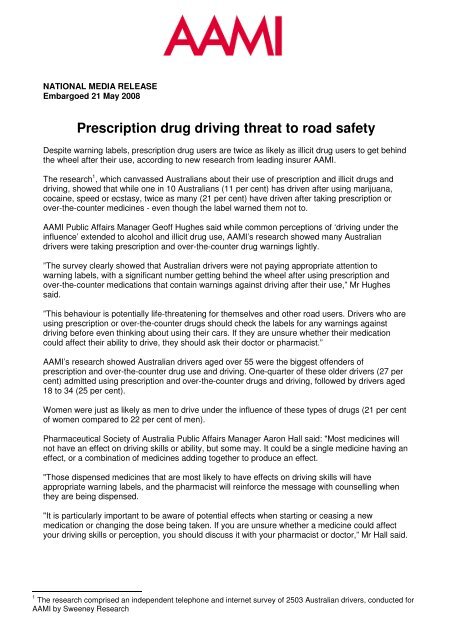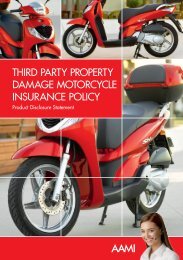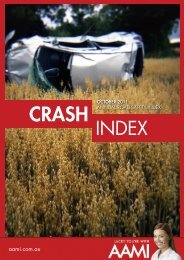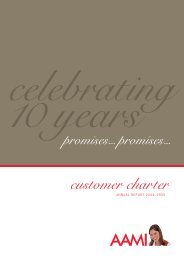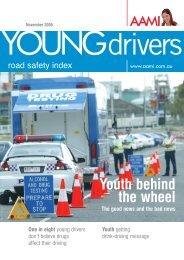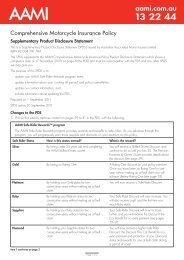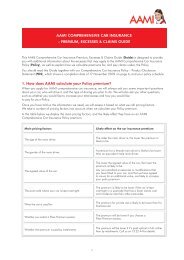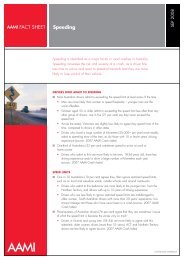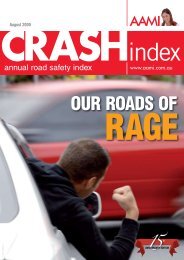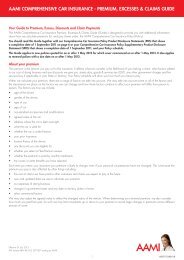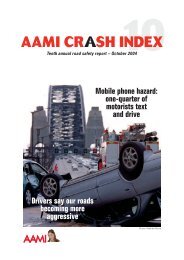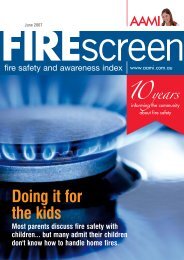Download PDF - AAMI
Download PDF - AAMI
Download PDF - AAMI
You also want an ePaper? Increase the reach of your titles
YUMPU automatically turns print PDFs into web optimized ePapers that Google loves.
NATIONAL MEDIA RELEASEEmbargoed 21 May 2008Prescription drug driving threat to road safetyDespite warning labels, prescription drug users are twice as likely as illicit drug users to get behindthe wheel after their use, according to new research from leading insurer <strong>AAMI</strong>.The research 1 , which canvassed Australians about their use of prescription and illicit drugs anddriving, showed that while one in 10 Australians (11 per cent) has driven after using marijuana,cocaine, speed or ecstasy, twice as many (21 per cent) have driven after taking prescription orover-the-counter medicines - even though the label warned them not to.<strong>AAMI</strong> Public Affairs Manager Geoff Hughes said while common perceptions of ‘driving under theinfluence’ extended to alcohol and illicit drug use, <strong>AAMI</strong>’s research showed many Australiandrivers were taking prescription and over-the-counter drug warnings lightly.”The survey clearly showed that Australian drivers were not paying appropriate attention towarning labels, with a significant number getting behind the wheel after using prescription andover-the-counter medications that contain warnings against driving after their use,” Mr Hughessaid.”This behaviour is potentially life-threatening for themselves and other road users. Drivers who areusing prescription or over-the-counter drugs should check the labels for any warnings againstdriving before even thinking about using their cars. If they are unsure whether their medicationcould affect their ability to drive, they should ask their doctor or pharmacist.”<strong>AAMI</strong>’s research showed Australian drivers aged over 55 were the biggest offenders ofprescription and over-the-counter drug use and driving. One-quarter of these older drivers (27 percent) admitted using prescription and over-the-counter drugs and driving, followed by drivers aged18 to 34 (25 per cent).Women were just as likely as men to drive under the influence of these types of drugs (21 per centof women compared to 22 per cent of men).Pharmaceutical Society of Australia Public Affairs Manager Aaron Hall said: "Most medicines willnot have an effect on driving skills or ability, but some may. It could be a single medicine having aneffect, or a combination of medicines adding together to produce an effect."Those dispensed medicines that are most likely to have effects on driving skills will haveappropriate warning labels, and the pharmacist will reinforce the message with counselling whenthey are being dispensed."It is particularly important to be aware of potential effects when starting or ceasing a newmedication or changing the dose being taken. If you are unsure whether a medicine could affectyour driving skills or perception, you should discuss it with your pharmacist or doctor,” Mr Hall said.1 The research comprised an independent telephone and internet survey of 2503 Australian drivers, conducted for<strong>AAMI</strong> by Sweeney Research
Crash experiences – alcohol the biggest causeWhile the use of medicinal and recreational drugs and driving is of major concern, the researchshows alcohol is far and away the substance that causes the most number of crashes.Of the four in five Australian drivers that have experienced a crash as a driver or passenger, 10 percent said alcohol was a contributing factor, compared to just two per cent point who saidrecreational drugs was a contributing factor, and one per cent who said prescription drugs wereinvolved.The research also showed that while older drivers were the most prolific users of prescription andover-the-counter drugs nationwide, respondents in that category indicated they had never beeninvolved in a crash related to them.Checking labels:Prescription drug packaging usually carries a special label outlining any specific warnings againstdriving:Note to editors: Following is some information on some common prescription and over-the-counterdrugs, and their possible side effects:Generic NameCommonbrand name(othersavailable)Used forPossible side effects(source: APP Guide Online www.appco.com.au)Diazepam Valium Anxiety, Insomnia Drowsiness, dizziness, or clumsinessAlprazolam Xanax Anxiety, Insomnia Confusion, drowsiness, dizziness, or clumsinessLorazepam Ativan Anxiety, Insomnia Vision changes, drowsiness, dizzinessFluoxetine Prozac Depression Abnormal vision, dizziness, ear ringinghydrochloridePheniramine Avil (retard) Allergies Drowsiness, dizziness, lack of concentrationmaleateParacetamol, Mersyndol Pain Dizziness, drowsinesscodeine phosphate,doxylaminesuccinateMethylmorphine Codeine Pain management Nausea, drowsiness, dizzinessMorphine sulfate Roxanol Pain management Muscle twitches, lightheadedness,unconsciousness, faintingHydrocodone Vicodin Pain management Light-headedness, dizzinessDiclofenac Sodium Voltaren Pain, Inflammation Seizures, weakness, dizziness, ear ringingEnds…For further information or to arrange an interview, contact Brian O’Neil, Public RelationsExchange, on 0411 055 284.Media Contacts: <strong>AAMI</strong>Pharmaceutical Society of AustraliaGeoff HughesAaron HallPublic Affairs Manager Public Affairs Manager03 8520 1469 or 0413 483 591 02 6283 4782 or 0402 756 835


